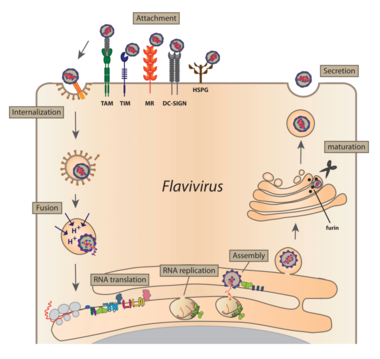DENGUE Virus
2. Replication Cycle
DV particles bind to cells via interactions between the surface glycoprotein and one or several poorly defined cellular receptor(s). In addition, particles may enter cells via Fc-receptor upon opsonization. Virions are internalized by receptor-mediated endocytosis resulting in release of the viral genome from the nucleocapsid in a low-pH dependent manner. Soon after infection, viral proteins induce rearrangments of intracellular membranes forming distinct structures that have been designated vesicle packets and convoluted membranes. It appears that vesicle packets correspond to the ER membrane invaginations and are sites of RNA replication that is probably catalyzed by a multi-protein complex composed of viral proteins, cellular membranes and presumably also cellular proteins. DV RNA is replicated via a negative strand intermediate that serves as a template for the production of excess amounts of positive strand progeny. Virus particles assemble by budding into the ER and are transported through the host secretory pathway.
The virus enters the cell by receptor-mediated endocytosis and after uncoating the viral RNA genome is translated at the rER. Viral proteins induce membrane alterations, most notably invaginations towards the ER lumen, serving as sites for RNA replication. Viral particles form via budding at ER membranes and particles are secreted via the secretory pathway.
